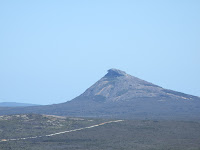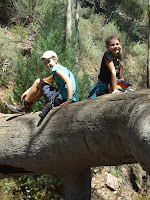Pining for the Fiords …………
We eased the crew away from the Tingle wood giants ever eastwards and with the light fading pulled into the Emu Beach Caravan Park on the outskirts of Albany. There was no real impression of what we would find at Albany, were planning only a quick overnight stop anyway, there was light drizzle, and to cut a long story short, we were not greatly overwhelmed by the place as we skirted the town.
Once the Trak Shak was set up, I reckoned that before I put dinner on I could steal a quick stroll through the coastal heath and dune for a glimpse of the bay on which Albany lies. Well, truth be known, I was overwhelmed at first sight. Albany and the surrounding King George Sound form one of those most captivating and awesome coastal landscapes. Huge granite boulders and islands rise up out of the water, the headlands and inlets of the Sound give one of the most picturesque, huge and peaceful harbours you will ever see. It rivals Port Jackson I reckon. It was enough to convince us to stay at least a day more and look around, which we gladly did.
Tucked up on the northern end of the Sound is the spreading and historic centre of Albany, with huge white wheat silos dominating the port area. Somehow they have managed to retain, conserve and re-use a large portion of their historic buildings, testimony to the fact that Albany was actually settled a couple of years prior to Perth. We set out on the ½ hour drive to the south-western head of the Sound into Torndirrup NP. This was the site of the last operating whaling station in Australia, where it shocked Maeve to know that we in Australia were still whaling until 1978. (Sort of makes our stand on the Japanese whaling activities a little curious). Out on the end of the peninsula you face the full face of the monstrous, rolling Southern Ocean. Massive sheets of bare, rounded granite at the waters edge give way to more low multi-coloured flowering heaths. They’ve actually been able to match up the rock formations along this part of the coast with their exact counterparts on the Antarctic continent. For those of us who feel we must get to Antarctica before we leave this earth – Jenny not wanting to be so included – this was a spiritual moment; so near, yet so far.
From Albany we headed for Esperance and Cape Le Grand. The further east we got, the lower and more sparse the vegetation became, yet somehow in these seemingly poor, sandy coastal soils, the huge plantings of wheat continue. They seem to do well, too.
Esperance the town did not grab us at all like Albany did, though it is obviously a popular holiday destination for Perth folk. The wheat port here is even larger than that in Albany, but Esperance Bay itself is more open, wind-swept and less inviting. A quick re-provisioning in town, and we scooted out for 3 nights in Cape Le Grand NP. Another stunning coastline here, again with huge granite outcrops on land leading into a trail of lower, submerged rock masses that make up the various islands of the Recherche Archipelago. At places, wind and sea have carved huge caves into the faces of the granite.
We were camped here on Lucky Bay, so called by Matthew Flinders as he took refuge from a Southern Ocean squall on his circumnavigation of the continent in 1802. As with much of the whole west coast of WA, place names and other snippets of information we came across provide constant reminders of the contacts between Aboriginal folk and the various European and Asian explorers, navigators, traders/exploiters and colonisers. In this part of the world it seemed to be mainly collaborations and competitions between the English and French and their Noongar hosts. We dragged the young’ns away from their hopeful fishing attempts for a few treks through the heathlands to some of the higher peaks here - Mt Mississippi being one - from where you get the most amazing views across the lands and waters that mark the western edge of the Great Australian Bight.
I think it was Flinders that named the highest, most prominent peak here as “Frenchmans Peak” – the beret-form cap on the mount a dead give-away as to which peak the name refers. The Noongar dreaming here refers to the peak as the mother “walich” or eagle, and their story for the place relates to how a couple of young Noongar kids stole her eggs, for which the mother eagle tracked them down, picked them up in her claws and dropped them out to sea. You can still seem them out there in the form of a couple of the islands lying close offshore.
Underneath the Frenchman’s cap is a humungous see-through cavern that some of Flinder’s party ventured into and recorded in their journals. It’s now a popular and invigorating climb up some pretty bare granite slidey slopes. Russ couldn’t resist and got in a rare solo adventure to the top, minus those pesky, slothful girls; the 3 of them pretending it was imperative that they remain instead at camp dangling a fishing line in Lucky Bay without real conviction. (This may sound harsh, but I just wanted to make them envious that they missed out on some really spekky views, as well as an exciting walk-cum-slide back down the side of the cap. Best perhaps they weren’t there to watch same.)
Jenny writes....I wanted to climb Frenchman's Cap, but the girls went on strike and refused, so I stayed behind to watch that they didn't get washed off the rocks whilst fishing! (Don't believe everything Russ writes!)
Next day came and pack up again we did, heading north then east via Norseman, endless wheat fields, broken by great stretches of mallee, for the much awaited Nullabor crossing.
“… bound for South Australia …” (to be read singing, as the auld shanty goes).
The Woonona Mob.
 |
| Flinders Peninsula. "Antarctica Dreaming" |
 |
| Fisher Folk @ Cape Le Grand |
 |
| View of Lucky Bay from our camp site. |
 |
| Heath flowers |
 |
| Looking out from Cape Le Grand |
 |
| Recherche Archipelago |
 |
| Russ the "wilderness explorer" spots a cave off the track.... |
 |
| and we dutifully follow. |
 |
| Miss Maeve looking more & more like Aunty Ro! |
 |
| At Mt. |
Mississippi
 |
| Climb every mountain...Mt Mississippi. |
 |
| View from Mt |
Mississippi
 |
| Frenchman's Cap....let's climb that as well! |
 |
| view from Frenchman's Cap |
 |
| Amazing heath eucalypt |
 |
| and it's pods. |
 |
| "Stonehenge"...Esperence style! Costs $5 to enter. Russ took this from the road, by standing on the car...and the owner saw him and started yelling. |






























































